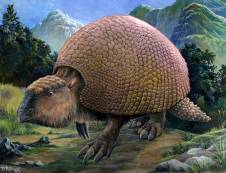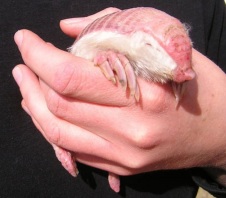When I was a kid, back in the Plastic Age, every kid had gotten a plastic bag full of little plastic dinosaurs. The wife and I still have plastic dinosaurs. Nice ones from the Natural History museum, and a collection of the old fashioned mono-color (an angry pink T Rex, a passive blue stegosaurus) that came in a wooden box we picked up at a yard sale. We wanted the box, we said, but we probably wanted the plastic dinosaurs. We keep them now, along with a collection of little Matchbox car knockoffs that we found in another box we bought (for the box, this time), for children and grandchildren, though our friends have remained mostly sterile, barren or child loathing, I’m never quite sure. So both the swarm of monocolored dinosaurs and the fleet of tiny cars sit unplayed with. But when I was a kid, the packages of plastic dinosaurs included the occasional post-asteroid apocalypse critters (we didn’t know about the asteroid back then, though, the reptilian mega beasts still died slowly and sadly like in Fantasia). I specifically remember a big bird and weird glyptodont.
 Mythical Gastornis, eating critter whole.
Mythical Gastornis, eating critter whole.The bird was a Gastornis, that we had envisioned ripping smaller beasts to pieces with its enormous beak, and I was a little disappointed to see last week that is was (according to news reports) a giant Vegan bird that once roamed the Arctic, assaulting trees and Eocene shrubbery.
 Real Gastornis, nibbling on a cycad.
Real Gastornis, nibbling on a cycad.I think ours was yellow, though, and looked meaner than a Vegan, and besides there were no Vegans in the 1960’s, just fruitarians. But it was still cool to see Gastornis going briefly viral, sent aloft by mildly confused Vegans, one of whom explained that we shouldn’t eat chicken because it was the closest living relative to a T Rex.
Then today I’m delighted to see the glyptodont in the news. A glypto what, you ask.
 A glyptodont, lumbering.
A glyptodont, lumbering.It looked like a huge armadillo, the size of a Volkswagen, and ours was mono-colored, though what color I can’t remember, and about the same size in plastic as the gastornis and looked kind of weird silly cute gnarly. It also looked exactly like an armadillo. I knew quite a bit about it, because I had read and re-read the How and Why Book of Prehistoric Mammals which I had read on yet another of the family’s cross country sojourns, just as I had read and re-read the How and Why Book of Dinosaurs on an early trip coast to coast. (We moved a lot.) As kids went, I was an expert on things prehistoric. Anyway, it turns out that scientists have recently retrieved DNA from a 12,000 year old glyptodont dug up somewhere. Perhaps it was slaughtered and devoured by ancestors of my Sioux wife, who had spread across the Americas with their fancy Clovis pointed spears driving mega fauna into extinction, leaving us with nothing but the bison, elk, moose and the avocados that giant sloths used to eat. All the elephants, camels, giant armadillos, giant sloths all went into the campfire barbeque. But paleontologists had no idea of what, exactly, a glyptodont was. Then after investigating the fossil’s DNA, it turns out that the glyptodont was a giant armadillo, more giant than today’s so-called giant armadillo. No mere Texas roadkill our glyptodont, it’d be like running your pickup into a bison. But oddly enough, the glyptodont is not especially close, genetically, to todays roadkill armadillos, but rather to the dinky little fairy armadillo
 Pink Fairy armadillo.
Pink Fairy armadillo.found throughout the Argentine pampas, and is about as unglyptodont an armadillo as you can imagine. Still, you can’t argue with DNA, which must drive paleontologists crazy, out there in the cold and wind and dirt prying out rocks with hammers looking for ancient bones. Every bone they dig up and tease out of its rock matrix with dental drills means hundreds of hours of work in the field and lab. Then in half an hour some pasty geneticist with a man bun tells you exactly what the thing was, a gigantic cousin of the pink fairy armadillo, and you can’t argue back. Pink fairy? Really? It’s bad enough your terrifying carnivorous avis was a herbivore, no more dangerous than a huge chicken, but now your mega armadillo was, deep down genetically, just a squeaky tiny armadillo. Fool with a couple hox genes, the heterochrony (sort of the rate of developmental change, like how we grow from fetus to adult, and how fast, and how much) switches from peramorphosis (keeps growing until huge, like a Great Dane, or me) to paedomorphosis (aka neoteny, becoming adult while still retaining juvenile characteristics, like those yappy little dogs in ladies’ purses). In an evolutionary instant your truck killing glyptodont is something you can slip into your pocket (in fact I once saw a pink fairy armadillo slipped into a pocket, where it felt instantly asleep).
All these dinosaurs, glyptodonts and even giant Vegan birds were once the work of hard drinking, hard living, hard travelling men who battled the elements and hostile natives to stock museums with visions of immense and terrifying beasts. Heroes like Edward Drinker Cope and Roy Chapman Andrews, who were feted at parties full of adoring ladies and Teddy Roosevelt would call them friends. Now it’s some geneticist schmuck with a pocket protector and a show on PBS. I wanted to be a paleontologist when I was a kid, they were heroes, they were all over public television in big macho documentaries, manly men in cowboy hats, beards, long hair blowing in the wind, holding up a huge thigh bone like a barbel and saying long Latin names like it was the most natural thing in the world. Beautiful grad students puttered abound in the dirt at their feet. At night there’d be beer drinking and loud laughter around a fire. Now that was science. Today it is long sequences of A’s and C’s and G’s and T’s. Not that genetics isn’t incredibly fascinating, it is. But where is the romance? A glyptodont lumbers along a lakeshore where Barstow is now. Some day it will be small and plastic and bright blue. And then it will be a sequence of A, C, G and T. Somewhere between the two my imagination watches it, wondering.
